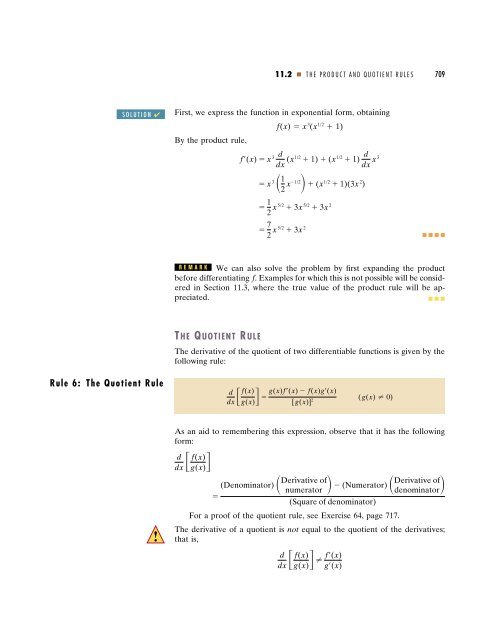11DIFFERENTIATION - Department of Mathematics
11DIFFERENTIATION - Department of Mathematics
11DIFFERENTIATION - Department of Mathematics
Create successful ePaper yourself
Turn your PDF publications into a flip-book with our unique Google optimized e-Paper software.
SOLUTION ✔<br />
Rule 6: The Quotient Rule<br />
11.2 THE PRODUCT AND QUOTIENT RULES 709<br />
First, we express the function in exponential form, obtaining<br />
f(x) x 3 (x 1/2 1)<br />
By the product rule,<br />
3 d<br />
f(x) x<br />
dx (x1/2 1) (x 1/2 1) d 3 x<br />
dx<br />
x 31 2 x1/2 (x 1/2 1)(3x 2 )<br />
1<br />
2 x 5/2 3x 5/2 3x 2<br />
7<br />
2 x 5/2 3x 2<br />
<br />
REMARK We can also solve the problem by first expanding the product<br />
before differentiating f. Examples for which this is not possible will be considered<br />
in Section 11.3, where the true value <strong>of</strong> the product rule will be appreciated.<br />
<br />
T HE Q UOTIENT R ULE<br />
The derivative <strong>of</strong> the quotient <strong>of</strong> two differentiable functions is given by the<br />
following rule:<br />
d<br />
dx f(x) g(x)f(x) f(x)g(x)<br />
<br />
g(x)<br />
[g(x)] 2<br />
(g(x) 0)<br />
As an aid to remembering this expression, observe that it has the following<br />
form:<br />
d<br />
dx f(x)<br />
g(x)<br />
Derivative <strong>of</strong><br />
Derivative <strong>of</strong><br />
(Denominator)<br />
numerator (Numerator)<br />
denominator<br />
<br />
(Square <strong>of</strong> denominator)<br />
For a pro<strong>of</strong> <strong>of</strong> the quotient rule, see Exercise 64, page 717.<br />
The derivative <strong>of</strong> a quotient is not equal to the quotient <strong>of</strong> the derivatives;<br />
that is,<br />
d<br />
dx f(x)<br />
g(x) f(x)<br />
g(x)

















